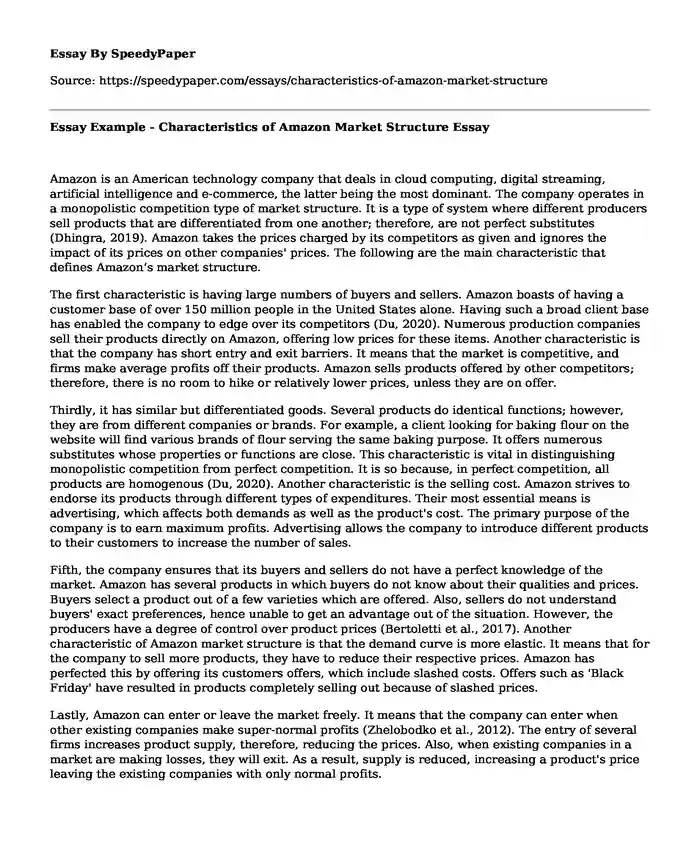
| Type of paper: | Essay |
| Categories: | Amazon Leadership style Leadership management |
| Pages: | 3 |
| Wordcount: | 616 words |
Amazon is an American technology company that deals in cloud computing, digital streaming, artificial intelligence and e-commerce, the latter being the most dominant. The company operates in a monopolistic competition type of market structure. It is a type of system where different producers sell products that are differentiated from one another; therefore, are not perfect substitutes (Dhingra, 2019). Amazon takes the prices charged by its competitors as given and ignores the impact of its prices on other companies' prices. The following are the main characteristic that defines Amazon’s market structure.
The first characteristic is having large numbers of buyers and sellers. Amazon boasts of having a customer base of over 150 million people in the United States alone. Having such a broad client base has enabled the company to edge over its competitors (Du, 2020). Numerous production companies sell their products directly on Amazon, offering low prices for these items. Another characteristic is that the company has short entry and exit barriers. It means that the market is competitive, and firms make average profits off their products. Amazon sells products offered by other competitors; therefore, there is no room to hike or relatively lower prices, unless they are on offer.
Thirdly, it has similar but differentiated goods. Several products do identical functions; however, they are from different companies or brands. For example, a client looking for baking flour on the website will find various brands of flour serving the same baking purpose. It offers numerous substitutes whose properties or functions are close. This characteristic is vital in distinguishing monopolistic competition from perfect competition. It is so because, in perfect competition, all products are homogenous (Du, 2020). Another characteristic is the selling cost. Amazon strives to endorse its products through different types of expenditures. Their most essential means is advertising, which affects both demands as well as the product's cost. The primary purpose of the company is to earn maximum profits. Advertising allows the company to introduce different products to their customers to increase the number of sales.
Fifth, the company ensures that its buyers and sellers do not have a perfect knowledge of the market. Amazon has several products in which buyers do not know about their qualities and prices. Buyers select a product out of a few varieties which are offered. Also, sellers do not understand buyers' exact preferences, hence unable to get an advantage out of the situation. However, the producers have a degree of control over product prices (Bertoletti et al., 2017). Another characteristic of Amazon market structure is that the demand curve is more elastic. It means that for the company to sell more products, they have to reduce their respective prices. Amazon has perfected this by offering its customers offers, which include slashed costs. Offers such as 'Black Friday' have resulted in products completely selling out because of slashed prices.
Lastly, Amazon can enter or leave the market freely. It means that the company can enter when other existing companies make super-normal profits (Zhelobodko et al., 2012). The entry of several firms increases product supply, therefore, reducing the prices. Also, when existing companies in a market are making losses, they will exit. As a result, supply is reduced, increasing a product's price leaving the existing companies with only normal profits.
References
Bertoletti, P., & Etro, F. (2017). Monopolistic competition when income matters. The Economic Journal, 127(603), 1217-1243.
Dhingra, S., & Morrow, J. (2019). Monopolistic competition and optimum product diversity under firm heterogeneity. Journal of Political Economy, 127(1), 196-232.
Du, Y. (2020). Who will win in the future digital market-Competitive Analysis between Amazon and Alibaba.
Zhelobodko, E., Kokovin, S., Parenti, M., & Thisse, J. F. (2012). Monopolistic competition: Beyond the constant elasticity of substitution. Econometrica, 80(6), 2765-2784.
Cite this page
Essay Example - Characteristics of Amazon Market Structure. (2023, Nov 24). Retrieved from https://speedypaper.com/essays/characteristics-of-amazon-market-structure
Request Removal
If you are the original author of this essay and no longer wish to have it published on the SpeedyPaper website, please click below to request its removal:
- Essay Example on Corporate Finance
- Risk Analysis at Tesco Ltd, Free Essay in Risk Management
- My Leadership Framework - Essay Sample
- Essay Sample on Banco Santander: Company Overview
- Essay Sample on Financial Management in Healthcare
- Essay Sample on An HR Podcast, "Covid-19"
- Essay on Facebook: Communication, Networking, Research, and Revenue in Cameroon
Popular categories




